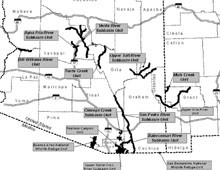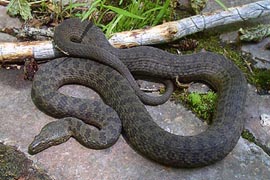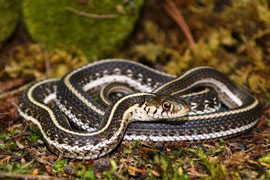Cronkite News has moved to a new home at cronkitenews.azpbs.org. Use this site to search archives from 2011 to May 2015. You can search the new site for current stories.
Feds target critical habitat in Arizona for endangered gartersnakes
WASHINGTON – The U.S. Fish and Wildlife Service has targeted hundreds of thousands of acres in New Mexico and Arizona that it wants to designate as critical habitat for two endangered gartersnakes.
The service said Wednesday that the northern Mexican gartersnake and the narrow-headed gartersnake need to be protected because they are threatened by loss of habitat and by competition from nonnative species like bullfrogs and crayfish.
Overall, more than 400,000 acres in Arizona and New Mexico are being considered for “critical habitat” for the snakes. Much of it is along the streambeds that are the snakes’ natural habitat – more than 900 miles of stream for the northern Mexican gartersnake and 1,500 miles of stream for the narrow-headed gartersnake.
“These snakes are in tough shape because their environments are in tough shape,” said Collette Adkins Giese, the reptile and amphibian staff attorney for the Center for Biological Diversity. The center had first petitioned the government to protect the snakes in 2003.
The wildlife service said that about 83 percent of northern Mexican gartersnakes and 76 percent of the narrow-headed gartersnakes “exist at low population densities.”
The narrow-headed gartersnake can primarily be found in northern and eastern Arizona, as well as southeastern Arizona and southwestern New Mexico, according to the announcement of the proposed designation in Wednesday’s Federal Register.
The northern Mexican gartersnake can be found in “all major watersheds” in Arizona, the posting said, as well as in southwestern New Mexico and northwestern Mexico, near the Arizona border.
Critical habitats, as defined by the Endangered Species Act, are “geographic areas that contain features essential for the conservation of a threatened or endangered species.” Federal agencies are required to consult with the Fish and Wildlife Service to make sure that any activity in a critical area does not “adversely modify or destroy” the habitat, according to a document from the service.
But the regulation unveiled Wednesday includes an exception to the proposed critical area rule for livestock tanks that farmers use to water their herds – a habitat the northern Mexican gartersnake finds particularly attractive. Farm groups welcomed the exception.
“In general, whenever the U.S. Fish and Wildlife Service makes an exception for farmers and ranchers, it’s a positive thing,” said Stefanie Smallhouse, second vice president of the Arizona Farm Bureau.
Smallhouse said the service is “getting better” about “not casting a wide net of regulations” that could affect how farmers maintain their lands.
The rule would exempt farmers and non-federal landowners if they find one of the protected snakes on their land and “harass, harm or kill a gartersnake during normal use, operation and maintenance of their livestock tanks.”
“The premise (of the exemption) is that these tanks are important habitats” for the northern Mexican gartersnake, said Jeff Servoss, a biologist for the wildlife service’s Arizona Ecological Services.
The exemption would not apply to the narrow-headed gartersnake, which is typically found in streams and other natural water environments.
Steve Spangle, the service’s Arizona field supervisor, said in a statement announcing the snakes’ designation that many people’s “earliest outdoor recollections include memories of frogs and gartersnakes.”
“Taking care of these Southwestern critters and habitats today, may guarantee our kids and grandkids can have such important experiences,” Spangle’s statement said.
The wildlife service will take public comment on the proposed rule until Sept. 9.










